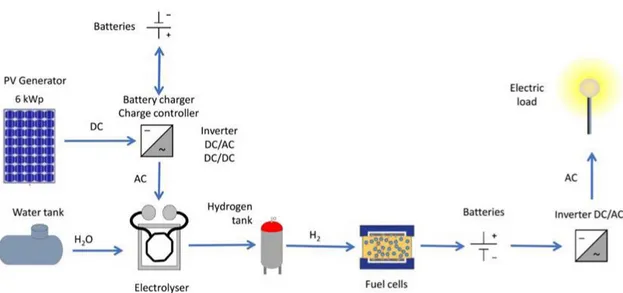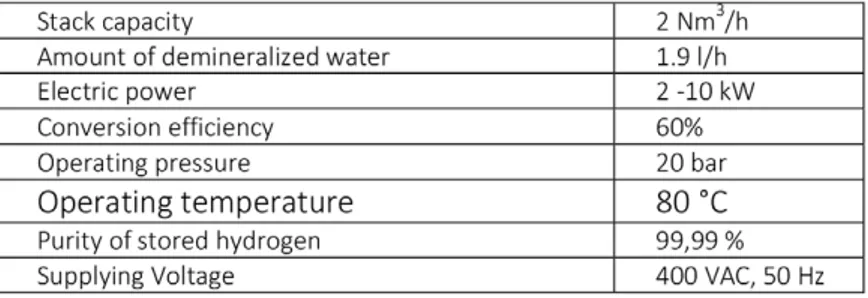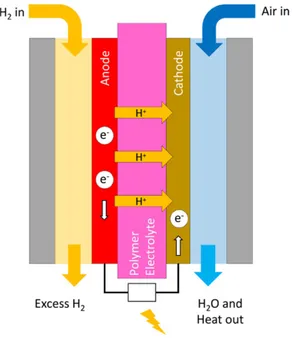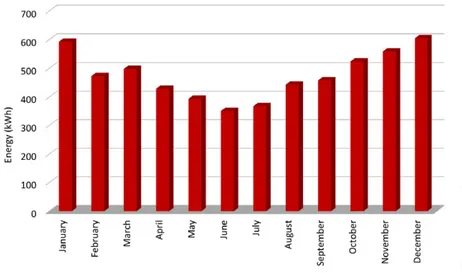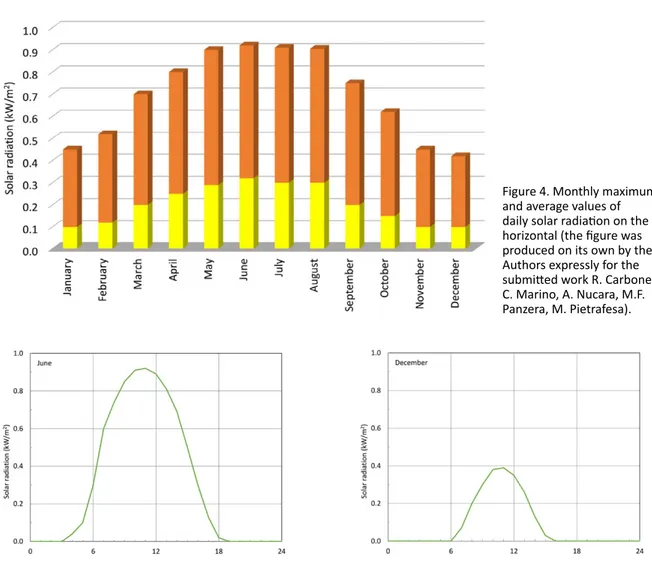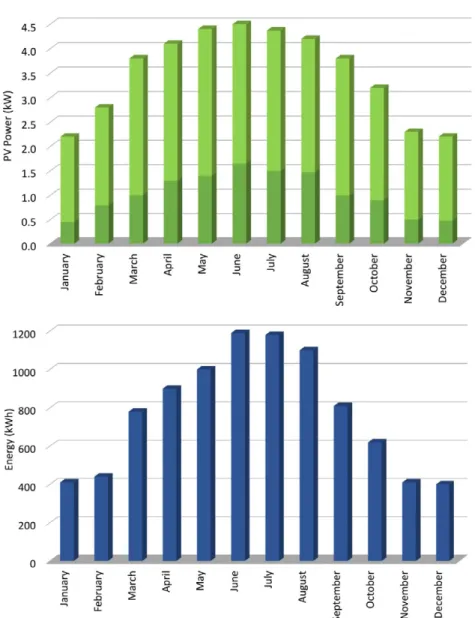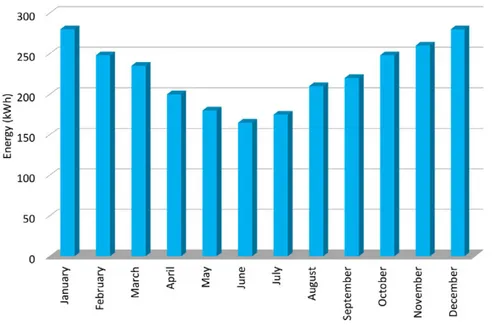ArcHistoR EXTRA 6 (2019)
www.archistor.unirc.it
La Mediterranea verso iL 2030
studi e ricerche sul patrimonio storico e sui paesaggi antropici, tra conservazione e rigenerazione
a cura di Marina Mistretta, Bruno Mussari, Adolfo Santini
t h e M e d i t e r r a n e a t o w a r d s 2 0 3 0
s t U d i e s a n d r e s e a r C h o n h i s t o r i C a L h e r i t a G e a n d a n t h r o P i C L a n d s C a P e s , C o n s e r vat i o n a n d r e G e n e r at i o n ISSN 2384-8898 ISBN 978-88-85479-08-1 Supplemento di ArcHistoR 12/2019Rosario Carbone, Concettina Marino, Antonino Nucara, Maria Francesca Panzera, Matilde Pietrafesa
[email protected], [email protected], antonino.nucara@ unirc.it, [email protected], [email protected]
Un caso studio di impianto per la riqualificazione sostenibile
degli edifici basato sullo stoccaggio e sulla riconversione
dell’idrogeno prodotto usando l’energia solare
Nell’odierno processo di decarbonizzazione e transizione verso un’economia verde basata sulla produzione di energia distribuita e sostenibile, l’idrogeno è considerato il vettore energetico più promettente, grazie alle sue molteplici proprietà: è pulito, versatile e ha un’alta efficienza di combustione. In particolare, l’energia rinnovabile potrebbe essere utilizzata come fonte primaria per la produzione di idrogeno vicino al punto di utilizzo finale, sfruttando appieno il potenziale energetico locale. Tuttavia, l’attuale costo della sua tecnologia richiede ancora ulteriori ricerche e sviluppi, necessari per ottenere la sua rapida ed efficace penetrazione nel mercato. Inoltre, al momento le infrastrutture di stoccaggio e distribuzione dell’idrogeno, fondamentali per renderlo utilizzabile e competitive, sono ancora lacunose.
In questo scenario, il lavoro analizza un sistema fotovoltaico (PV), dotato di sottosistemi di stoccaggio e riconversione dell’idrogeno. L’impianto tecnologico è pensato per essere facilmente integrato negli edifici per una loro riqualificazione sostenibile; in questa fase, il caso di studio testato era finalizzato alla alimentazione di una parte delle utenze elettriche dell’Università Mediterranea di Reggio Calabria.
In breve, a partire dalla generazione fotovoltaica di elettricità, l’idrogeno viene ottenuto attraverso la produzione elettrolitica, immagazzinato e poi riconvertito in elettricità utilizzando le celle a combustibile. Lo studio è chiaramente in linea con i principali Obiettivi dell’Agenda 2030 per uno sviluppo sostenibile.
t h e M e d i t e r r a n e a t o w a r d s 2 0 3 0
s t U d i e s a n d r e s e a r C h o n h i s t o r i C a L h e r i t a G e a n d a n t h r o P i C L a n d s C a P e s , C o n s e r vat i o n a n d r e G e n e r at i o n
A new sustainable energy paradigm should be established in the next future to fully realize the
decarbonization process. It should be based on RES distributed micro-generation
1, smart grids
2,
electric mobility
3, storage and hydrogen.
Buildings and their construction sectors, in particular, are globally responsible of 36% of global
final energy consumption, corresponding to nearly 40% of CO
2emissions
4. this can be easily linked to
the population growth and to the changes in the society, making people work more and spend more
time indoors
5. In this frame, redevelopment of buildings by introducing technological plants based
on RES distributed micro-generation could be very effective.
RES electricity production, characterized by variable and unpredictable over time availability,
can efficiently satisfy loads coupled with storage systems. They are based on different techniques
6:
1. Hvelplund 2006; Official Journal of the European Union (OJEU) 2009; Gonçalves da Silva 2010; Lund 2010; Malara et alii 2016; Foley, Olabi 2017; Kyriakopoulos et alii 2018; Narayanan et alii in press.
2. Gelazaskas, Gamage 2014; Siano 2014.
3. Briggs et alii 2016; Gattuso et alii 2016; Sinigaglia et alii 2017. 4. International Energy Agency (IEA) 2019.
mechanical, electric, chemical, thermal and biological, although the most widespread and versatile
systems are at the moment batteries
7.
One of the most environmentally sustainable methods to accumulate renewable energy is its use
as a primary source for electrolytic hydrogen production
8, subsequently reconverted in electricity
in fuel cells
9; production can take place both in large plants or in small generation units close to the
final use point (buildings)
10. Hydrogen production and reconversion process is the only generating no
carbon dioxide emissions, being its only byproducts water and heat
11.
Due to its environmental sustainability and energetic performances (it is clean, versatile and has
a high combustion efficiency), interest for hydrogen use as energy carrier is today increasing
12. it can
address multiple power sectors and applications across stationary
13, transportation
14and portable;
it can provide energy at all scales, ranging from micro-power sources for small devices to multi-MW
power plants
15.
In the paper a low-power (6 kWp) PV system providing electrical energy for the lighting of a
University parking is presented, together with its energetic behavior. The storage of the generated
electrical energy is basically achieved through production and accumulation of electrolytic hydrogen,
reconverted into electricity, when needed, by using fuel cells.
7. Carbone 2015.
8. Knut 1998; Agbossou et alii 2004.
9. Hoffmann 2001; Kelly 2014; Marino et alii 2015.
10. Santarelli, Macagno 2004; Avril et alii 2010; Dincer, Rosen 2011; Marino et alii 2012; Chaubey et alii 2013; Marino et alii 2013; Marino et alii 2015; Won et alii 2017.
11. Goel et alii 2003; Kreith, West 2004; Hosseini, Wahid 2016; Da Silva Veras et alii 2017; Carroquino et alii 2018; Lorestani, Ardehali 2018.
12. Afgan, Carvalho 2004; Momirlana, Veziroglu 2005; Barbir 2009; Bockris 2013; Marchenko, Solomin 2015; Ball, Weeda 2015; Nikolaidis, Poullikkas 2017; Cao et alii 2018.
13. Moreno-Benito et alii 2017. 14. Demir 2018.
Structure of the Technological Plant
The case-study plant (fig. 1) essentially consists of: a RES section, based on PV panels and an
hybrid inverter equipped with a first-level battery pack, a hydrogen production section, containing
an electrolyzer, a water tank and a tank for the gas storage, a power section, based on a fuel cell,
coupled to a second-level battery pack and an inverter specifically devoted to the feeding of the load,
and a control section, with a Programmable Logic Controller (PLC) for monitoring process execution.
The system operation is as follows: during the day, the electrical power produced by PV panels
is converted into alternating current by the three-phase inverter for supplying the electrolyzer
generating hydrogen. The surplus PV power is managed by the same hybrid inverter for charging the
first-level battery. A fuel cell converts hydrogen into electrical energy when it is needed, sending it
to a second-level battery pack, after which a second inverter supplies the AC load, also in absence of
solar radiation.
Figure 1. Scheme of the PV plant with hydrogen generation, storage and reconversion (the figure was produced on its own by the Authors expressly for the submitted work R. Carbone, C. Marino, A. Nucara, M.F. Panzera, M. Pietrafesa).
PV Generator
The 6kWp PV generator consists of monocrystalline silicon panels, the technical characteristics of
which are shown in Table 1. It is formed by 2 strings connected in parallel, each consisting of 9 panels
in series, with 15° lying, S-SE (160°N) facing.
Three-Phase Hybrid Inverter
Between the PV panels and the load there is a single device that includes a DC/DC converter (with
charge regulator function for the first-level battery pack), double Maximum Power Point Tracker
(MPPT) and a three-phase DC/AC inverter. DC required for electrolyzer operation is supplied by a
dedicated controlled rectifier. The characteristics of the inverter are reported in Table 2; it supplies
with priority the electrolyzer and subsequently other loads.
First-Level Battery Pack
Downstream the inverter a 240 V pack of 5 lithium batteries with 12 kWh total capacity is present
to accumulate energy generated by PV generator. Each battery has a nominal voltage of 48 V and a
nominal capacity of 50 Ah. They have reduced self-discharge and maintain charge up to 6 months,
with no memory effect.
Left, table 1. Characteristics of PV panels; bottom, table 2. Characteristics of the hybrid inverter.
Demineralizer
The electrolyzer needs demineralized water with the characteristics shown in Table 3; it is
contained in a water tank for its reintegration.
Electrolyzer
Starting from demineralized water and PV energy, the electrolyzer produces hydrogen which is
compressed and stored in the tank before being sent to the fuel cell. Its main characteristics are
reported in table 3.
Separation Tanks
Hydrogen and oxygen generated in the cell come out in a two-phase composition (liquid and gas)
mixed with KOH particles, and enter into separation tanks where the gaseous phases separate from
the liquid ones, which deposit on the bottom of the tank and return into the electrolyzer. Potassium
hydroxide is entirely reused, while water must be reintegrated.
Gas Purifier
Before being released the two gases are purified by filters. Hydrogen is purified in a dedicated
section by filters for KOH and oxygen removing and water absorption.
Table 3. Technical characteristics of the electrolyzer.
Figure 2. Scheme of a Fuel cell (the figure was produced on its own by the Authors expressly for the submitted work R. Carbone, C. Marino, A. Nucara, M.F. Panzera, M. Pietrafesa).
Water Refrigerating Chiller
the excess heat released during the process is removed by a water-cooling circuit which exchanges
heat with the electrolyte that is recirculated. its cooling power is 7.5 kw.
Storing Tank
hydrogen is stored in a tank with a capacity of 0.7 m3 at a maximum pressure of 30 bar, protected
from direct solar radiation and placed in a dry, cool and ventilated environment.
Fuel Cell
Fuel cell transforms chemical energy into electrical energy in direct current. A fuel (typically
hydrogen) and an oxidant (oxygen or air) enter the cell, from which direct current, water and heat
are obtained. Inside the cell there are two electrodes (anode and cathode), respectively lapped by
the fuel and the oxidizer, separated by an electrolyte for the conduction of the ions produced by a
reaction and consumed by the other, closing the electric circuit. The effluent is pure water, free of
polluting substances.
A scheme of the process is reported in Figure 2.
The most suitable cells for our case are the Proton Exchange Membranes (PEMs) which main
characteristics are shown in Table 4.
Second-Level Battery Pack
At the exit from the fuel cell there is a 48 V battery pack for energy accumulation: each battery
has a nominal voltage of 12 V and a nominal capacity of 92 Ah.
Fuel Cell Inverter
The fuel cell inverter is used both for supplying the AC load and for regulating charge of the
second-level battery; its characteristics are reported in Table 5.
Table 4. Characteristics of the fuel cell.
Control System
A Programmable Logic Controller (PLC) monitors and controls all process parameters in order to
guarantee its correct execution, as well as to ensure the safety of the system. In case of failures, it
emits alarms and stops the gas production.
Starting Operation
In order to work in safety conditions and prevent explosions, the plant is inertized both at its
turning on and off through nitrogen injection, at a pressure of 7-25 bar; this operation eliminates
oxygen in the starting phase and hydrogen in the stopping one, depressurizing the system.
Analysis of the System Functioning
The energetic analyses were conducted starting from the values of the maximum power
delivered by the fuel cell and the input power to the electrolyzer, for determining the optimal system
configuration to fulfil the load.
A necessary condition for the system to function properly is to achieve a positive annual balance
between hydrogen production and consumption: the storage system must therefore have the
capacity to meet periods of low production, such as winter. Furthermore, the PV generator and the
tank must be adequately sized so as not to have PV production surplus that cannot be converted into
hydrogen due to tank capacity limits (0.75 m
3)
or stored in the batteries.
The global efficiency of the process is:
where:
εEL electrolyzer efficiency
εFC fuel cell efficiency.
The energetic analysis and that of hydrogen production have been carried out on an hourly
basis using the HOMER simulation and optimization model (Hybrid Optimization of Multiple Energy
Resources), a dynamic software developed by the National Renewable Energy Laboratory (NREL),
USA, for the evaluation of technologies and plant types with thermal and electrical generation.
Electrical Load
First step was the assessment of the hourly electrical load of headlights for the lighting of the
parking areas of Engineering Departments. Operating in the evening, the load is powered only by
the fuel cell.
Considering the maximum power deliverable by the fuel cell (1’676 W) and taking into account
power losses, the maximum load that can be supplied by the cell is 1’300 W. Attention has been
focused on 52 lamps of 25 W each, for a total power of 1’300 W and an annual consumption of 5’694
kWh. The monthly consumption trend is shown in Figure 3.
Climatic Data
Hourly values of the global solar radiation incident on a horizontal surface, registered by a
pyranometer installed next to the system, were used. hourly air temperature data have been
registered by a flanked meteorological station. The analyzed reference period is the year 2017.
Figure 4 shows the monthly maximum and average values of solar radiation on the horizontal in
the year, while in Figure 5 the monthly average daily trends in the months of maximum and minimum
Figure 3. Monthly trend in load electricty consumption (the figure was produced on its own by the Authors expressly for the submitted work r. Carbone, C. Marino, a. Nucara, M.F. Panzera, M. Pietrafesa).
Figure 5. Average hourly solar radiation profile in June and December 2017 (the figure was produced on its own by the Authors expressly for the submitted work R. Carbone, C. Marino, A. Nucara, M.F. Panzera, M. Pietrafesa).
Figure 4. Monthly maximum and average values of daily solar radiation on the horizontal (the figure was produced on its own by the Authors expressly for the submitted work R. Carbone, C. Marino, a. nucara, M.F. Panzera, M. Pietrafesa).
Hydrogen Production and Efficiency
Hourly hydrogen production, at pressure p = 1,01325 bar and temperature T = 0 °C, with reference
to the maximum hourly energy entering the electrolyzer (𝐸𝑚𝑎𝑥= 10 kWh) is:
where 𝜌𝐻
2is hydrogen density ;
it follows:
Electrolyzer efficiency is given by:
where 𝜌ci𝐻
2is hydrogen lower calorific value
whereas electrolyzer consumption is
.
Consequently:
Figure 6. Maximum and average daily power
production on a monthly base (the figure was produced on its own by the authors expressly for the submitted work r. Carbone, C. Marino, a. nucara, M.F. Panzera, M. Pietrafesa).
Figure 7. Energy production of the plant on a monthly base (the figure was produced on its own by the Authors expressly for the submitted work R. Carbone, C. Marino, a. nucara, M.F. Panzera, M. Pietrafesa).
wherein the volume
is positive in the production phase and negative in the consumption one.
The capacity of the tank is dimensioned in relation to the maximum storage during the year Amax:
where:
A
maxis hydrogen maximum storage during the year
𝜌𝐻
2is hydrogen density
R is gas constant
T is the temperature
p is hydrogen maximum pressure in the tank
PM 𝐻
2is hydrogen molecular weight
Being the maximum annual storage a
max= 30 kg, the capacity of the tank, at maximum pressure
250 bar (compression absorbs about 2% of the gas energy content) is 1.02 m
3; for a tank volume 0.75
m
3it is necessary to use 2 tanks.
Hydrogen Consumption and Fuel Cell Production
Hydrogen volume consumed by the fuel cell is given by:
εFC efficiency of the fuel cell
PCI 𝐻
2hydrogen calorific value
.
During the year the fuel cell consumes 119 kg of hydrogen whereas the electrolyzer produces 125
kg: consequently the difference between annual production and consumption is 6 kg. The energy
monthly produced is shown in Figure 8.
Summary Results
Table 6 shows the values of production and consumption of both energy and hydrogen in the
various components.
Figure 8. Fuel cell energy production (the figure was produced on its own by the Authors expressly for the submitted work R. Carbone, C. Marino, a. nucara, M.F. Panzera, M. Pietrafesa).
Table 6. Production and consumption of energy and hydrogen in the various components.
Economic Considerations
With an initial investment of € 100’000 for the entire system, the energy production cost is 0.80
€/kWh: high figure compared to the value of 0.22 €/kWh of energy withdrawal from the national
electric grid; in order to become competitive the system should cost about ¼ of present value.
Economic convenience increases using PV production redundancies; also thermal energy
produced by some components of the system (electrolyzer and fuel cell), currently not used, could
be exploited. In this case, the annual cost of electricity production will be reduced by that required
to meet the electrical and thermal loads.
Conclusions
An application of hydrogen technologies for the sustainable redevelopment of buildings has been
presented and discussed. The paper analyses a photovoltaic (PV) system, equipped with hydrogen
production, storage and reconversion subsystems; the sizing procedure of its components chain has
been evidenced with detail.
The main critical aspects of electrolytic hydrogen production and reconversion in fuel cells consist
in the low global efficiency of the process (24 %) and in the big hydrogen volumes necessary to satisfy
the demand. Moreover, the cost of the energy unit stored in hydrogen presently is greater than the
unitary one produced by PV or wind systems or taken from the grid.
Consequently, although mature, from an economic point of view, hydrogen technology currently
is non-competitive and in order to have acceptable pay back times the system investment cost
should be reduced to about 1/4 of the current value or incentivizing policies should be introduced
for attributing to hydrogen production fares able to cover major costs of its technology.
Bibliography
Afgan, Carvalho 2004 - N.H. Afgan, M.G. Carvalho, Sustainability assessment of hydrogen energy systems, in «International Journal of Hydrogen Energy», 2004, 29, Issue 13, pp. 1327-1342, https://doi.org/10.1016/j.ijhydene.2004.01.005 (accessed 15 March 2019).
Agbossou et alii 2004 - K. Agbossou et alii, Electrolytic hydrogen based renewable energy system with oxygen recovery
and re-utilization, in «Renewable Energy», 2004, 29, Issue 8, pp. 1305-1318, https://doi.org/10.1016/j.renene.2003.12.006
(accessed 25 October 2019).
Arsalis, Alexandrou, Georghiou 2018 - A. Arsalis, A.N. Alexandrou, G.E. Georghiou, Thermoeconomic modelling of
a completely autonomous, zero-emission photovoltaic system with hydrogen storage for residential applications, in
«Renewable Energy», 2018, 126, pp. 354-369, https://doi.org/10.1016/j.renene.2018.03.060 (accessed 7 April 2019). Avril et alii 2010 - S. Avril et alii, Multi-objective optimization of batteries and hydrogen storage technologies for remote
photovoltaic systems, in «Energy», 2010, 35, Issue 12, pp. 5300-5308, https://doi.org/10.1016/j.energy.2010.07.033
(accessed 9 October 2019).
Ball, Weeda 2015 - M. Ball, M. Weeda, The hydrogen economy. Vision or reality?, in «International Journal of Hydrogen Energy», 2015, 40, Issue 25, pp. 7903-7919, https://doi.org/10.1016/j.ijhydene.2015.04.032 (accessed 18 March 2019). Barbir 2009 - F. Barbir, Transition to renewable energy systems with hydrogen as an energy carrier, in «Energy» 2009, 34, pp. 308-312, https://doi.org/10.1016/j.energy.2008.07.007 (accessed 18 March 2019).
Bockris 2013 - J.O.M. Bockris, The hydrogen economy: Its history, in «International Journal of Hydrogen Energy», 2013, 38, pp. 2579-2588, https://doi.org/10.1016/j.ijhydene.2012.12.026 (accessed 18 March 2019).
Briggs et alii 2016 - I. Briggs et alii, Sustainable non-automotive vehicles: The simulation challenges, in «renewable and Sustainable Energy Reviews», 2016, 68, Part 2, pp. 840-851, https://doi.org/10.1016/j.rser.2016.02.018 (accessed 13 March 2019).
Cao, Dai, Liu 2016 - X. Cao, X. Dai, J. Liu, Building energy-consumption status worldwide and the state-of-the-art
technologies for zero-energy buildings during the past decade, in «Energy and Buildings», 2016, 128, pp. 198-213, https://
doi.org/10.1016/j.enbuild.2016.06.089 (accessed 21 April 2019).
Cao et alii 2018 - F. Cao et alii, Development of the direct solar photocatalytic water splitting system for hydrogen production
in Northwest China: Design and evaluation of photoreactor, in «Renewable Energy», 2018, 121, pp. 153-163, https://doi.
org/10.1016/j.renene.2018.01.016 (accessed 7 April 2019).
Carbone 2015 - R. Carbone, PV Plants with Distributed MPPT founded on Batteries, in «Solar Energy», 2015, 122, pp. 910-923. Carroquino et alii 2018 - J. Carroquino et alii, Combined production of electricity and hydrogen from solar energy and
its use in the wine sector, in «Renewable Energy», 2018, 122, pp. 251-263, https://doi.org/ 10.1016/j.renene.2018.01.106
(accessed 15 March 2019).
Chaubey et alii 2013 - R. Chaubey et alii, A review on development of industrial processes and emerging techniques for
production of hydrogen from renewable and sustainable sources, in «Renewable and sustainable energy reviews», 2013,
Dincer, Rosen 2011 - I. Dincer, M.A. Rosen, Sustainability aspects of hydrogen and fuel cell systems, in «Energy for sustainable development», 2011, 15, pp. 137-146, https://doi.org/10.1016/j.esd.2011.03.006 (accessed 9 September 2019).
Foley, Lobera 2013 - A. Foley, D. Lobera, Impacts of compressed air energy storage plant on an electricity market with
a large renewable energy portfolio, in «Energy», 2013, 57, pp. 85-94, https://doi.org/10.1016/j.energy.2013.04.031
(accessed 25 May 2019).
Foley, Olabi 2017 - A. Foley, A.G. Olabi, Renewable energy technology developments, trends and policy implications that
can underpin the drive for global climate change, in «Renewable and Sustainable Energy Reviews», 2017, 68, Part 2, pp.
1112-1114, https://doi.org/10.1016/j.rser.2016.12.065 (accessed 13 March 2019).
Gattuso et alii 2016 - D. Gattuso et alii, Sustainable Mobility: Environmental and Economic Analysis of a Cable Railway,
Powered by Photovoltaic System, in «International Journal of Heat and Technology», 2016, 34/1, pp. 7-14, https://doi.
org/10.18280/ijht.340102 (accessed 1 May 2019).
Gelazaskas, Gamage 2014 - L. Gelazaskas, K.A.A. Gamage, Demand side management in smart grid: a review and proposal
for future direction, in «Sustainable Cities and Societies», 2014, 11, pp. 22-30.
Goel et alii 2003 - N. Goel, D.J. Goswami, S.T. Mirabal, H.A. Ingley, Hydrogen Production, in «advances in solar energy: an Annual Review of Research and Development», 2003, 15, pp. 411-416.
Gonçalves da Silva 2010 - C. Gonçalves da Silva, Renewable energies: choosing the best options, in «Energy», 2010, 35, pp. 3179-3193, https://doi.org/10.1016/j.energy.2010.03.061 (accessed 13 March 2019).
Hoffmann 2001 - P. Hoffmann, Tomorrow’s Energy: Hydrogen, Fuel Cells and the Prospects for a Cleaner Planet, the Mit Press, Cambridge, Massachusetts 2001, https://doi.org/10.1017/S1466046602251261 (accessed 13 October 2019). Hosseini, Wahid 2016 - S.E. Hosseini, M.A. Wahid, Hydrogen production from renewable and sustainable energy resources:
Promising green energy carrier for clean development, in «Renewable and sustainable energy reviews», 2016, 57, pp.
850-866, https://doi.org/10.1016/j.rser.2015.12.112 (accessed 21 February 2019).
Hvelplund 2006 - F. Hvelplund, Renewable energy and the need for local energy markets, in «Energy», 2006, 31, pp. 2293-2302, https://doi.org/10.1016/j.energy.2006.01.016 (accessed 13 March 2019).
Kelly 2014 - N.A. Kelly, Hydrogen production by water electrolysis, in A. Basile, A. Iulianelli (eds.), Advances in
Hydrogen production storage and distribution, Woodhead Publishing, Cambridge 2014, pp. 159-185, https://doi.
org/10.1533/9780857097736.2.159 (accessed 25 October 2019).
Knut 1998 - A. Knut, Hydrogen production by electrolysis, in t.o. Saetre (eds.), Hydrogen Power: Theoretical and
Engineering Solutions, Proceedings of the HYPOTHESIS II Symposium, (Grimstad, Norway, August 18-22, 1997), Klewer
Krajacic et alii 2012 - G. Krajacic et alii, Analysis of financial mechanisms in support to new pumped hydropower storage
projects in Croatia, in «Applied Energy», 2012, 101, pp. 161-171, https://doi.org/10.1016/j.apenergy.2012.07.007 (accessed
21 April 2019).
Kreith, West 2004 - F. Kreith, R. West, Fallacies of a Hydrogen Economy: A Critical Analysis of Hydrogen Production and
Utilization, in «Journal of Energy Resources Technology», 2004, 126, pp. 249-257, https://doi.org/10.1115/1.1834851
(accessed 21 February 2019).
Kyriakopoulos et alii 2018 - G. Kyriakopoulos et alii, Electricity consumption and RES plants in Greece: Typologies of
regional units, in «Renewable Energy», 2018, 127, pp. 134-144, https://doi.org/10.1016/j.renene.2018.04.062 (accessed
13 March 2019).
Lopez-Sabiron et alii 2014 - A.M. Lopez-Sabiron et alii, Carbon footprint of a thermal energy storage system using phase
change materials for industrial energy recovery to reduce the fossil fuel consumption, in «Applied Energy», 2014, 135, pp.
616-624, https://doi.org/10.1016/j.apenergy.2014.08.038 (accessed 25 May 2019).
Lorestani, Ardehali 2018 - A. Lorestani, M.M. Ardehali, Optimization of autonomous combined heat and power system
including PVT, WT, storages, and electric heat utilizing novel evolutionary particle swarm optimization algorithm, in
«Renewable Energy», 2018, 119, pp. 490-503, https://doi.org/10.1016/j.renene.2017.12.037 (accessed 15 March 2019). Lund 2010 - H. Lund, The implementation of renewable energy systems. Lessons learned from the Danish case, in «Energy», 2010, 35, pp. 4003-4009, https://doi.org/10.1016/j.energy.2010.01.036 (accessed 13 March 2019).
Malara et alii 2016 - A. Malara et alii, Energetic and economic analysis of shading effects on PV panels energy production, in «International Journal of Heat and Technology», 2016, 34/3, pp. 465-472, https://doi.org/10.18280/ijht.340316 (accessed 13 March 2019).
Marchenko, Solomin 2015 - O.V. Marchenko, S.V. Solomin, The future energy: Hydrogen versus electricity, in «International Journal of Hydrogen Energy», 2015, 40, pp. 3801-3805, https://doi.org/10.1016/j.ijhydene.2015.01.132 (accessed 18 March 2019).
Marino et alii 2012 - C. Marino et alii, Energetic, economic and environmental sustainability of integrated techniques for
energy production in buildings using hydrogen as storage system, in «Renewable Energy & Power Quality Journal», 2012,
10, pp. 663-668, https://doi.org/10.24084/repqj10.663 (accessed 9 October 2019).
Marino et alii 2013 - C. Marino et alii, An energy self-sufficient public building using integrated renewable sources
and hydrogen storage, in «Energy», 2013, 57, pp. 95-105, https://doi.org/10.1016/j.energy.2013.01.053 (accessed 12
September 2019).
Marino et alii 2015a - C. Marino et alii, Hydrogen production from RES, storage and reconversion in fuel cells, in V. Garg, J. Mathur (eds.), Proceedings of the 14th International Building Simulation Conference, (Hyderabad, India, December 7-9,
2015), BS publications, Hyderabad 2015, pp. 1149-1156.
Marino, Nucara, Pietrafesa 2015b - C. Marino, A. Nucara, M. Pietrafesa, Electrolytic hydrogen production from
renewable source, storage and reconversion in fuel cells: the system of the Mediterranea University of Reggio Calabria,
2019).
Narayanan et alii in press - A. Narayanan et alii, Feasibility of 100% renewable energy-based electricity production for
cities with storage and flexibility, in «Renewable Energy», in press.
Nikolaidis, Poullikkas 2017 - P. Nikolaidis, A. Poullikkas, A comparative overview of hydrogen production processes, in «Renewable and sustainable energy reviews», 2017, 67, pp. 597-611, https://doi.org/10.1016/j.rser.2016.09.044 (accessed 18 March 2019).
Official Journal of the European Union (OJEU) 2009 - Official Journal of the European Union (OJEU), On the promotion
of the use of energy from renewable sources, 5 June 2009, 140, pp. 63-73, https://eur-lex.europa.eu/LexUriServ/LexUriServ.
do?uri=OJ:L:2009:140:0016:0062:EN:PDF
Santarelli, Macagno 2004 - M. Santarelli, S. Macagno, Hydrogen as an energy carrier in stand-alone applications based
on PV and micro-hydro systems, in «Energy», 2004, 29, pp. 1159-1182, https://doi.org/10.1016/j.energy.2004.02.023
(accessed 15 October 2019).
Siano 2014 - P. Siano, Demand responde and smart grids. A survey, in «Renewable and sustainable energy reviews», 2014, 30, pp. 461-478.
Sinigaglia et alii 2017 - T. Sinigaglia et alii, Production, storage, fuel stations of hydrogen and its utilization in automotive
applications-a review, in «International Journal of Hydrogen Energy», 2017, 42, pp. 24597-24611, https://doi.org/10.1016/j.
ijhydene.2017.08.063 (accessed 13 March 2019).
Sunita Sharma, Krishna 2015 - S. Sunita Sharma, G. Krishna, Hydrogen the future transportation fuel: From production
to applications, in «Renewable and sustainable energy reviews», 2015, 43, pp. 1151-1158, https://doi.org/10.1016/j.
rser.2014.11.093 (accessed 7 April 2019).
Won et alii 2017 - W. Won et alii, Design and operation of renewable energy sources based hydrogen supply system:
Technology integration and optimization, in «Renewable energy», 2017, 103, pp. 226-238, https://doi.org/10.1016/j.
renene.2016.11.038 (accessed 21 September 2019).
Yilanci, Dincer, Ozturk 2008 - A. Yilanci, I. Dincer, H.K. Ozturk, A review on solar-hydrogen/fuel cell hybrid energy
systems for stationary applications, in «Progress in Energy and Combustion Science», 2008, 35, pp. 231-244, https://doi.
